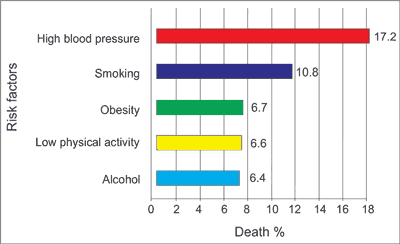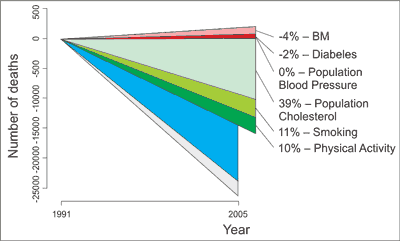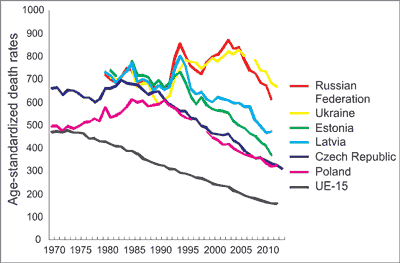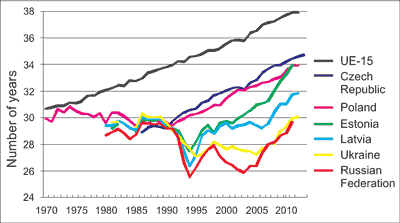© Borgis - Postępy Nauk Medycznych 9/2016, s. 682-687
*Kalina Kawecka-Jaszcz, Marek Klocek
The expectancy and quality of life in hypertension
Długość i jakość życia w nadciśnieniu tętniczym
1st Department of Cardiology, Interventional Electrocardiology and Hypertension, Jagiellonian University Medical College, Kraków
Head of Department: Professor Danuta Czarnecka MD, PhD
Streszczenie
Nadciśnienie tętnicze jest jednym z najbardziej rozpowszechnionych schorzeń na świecie, wiodącym czynnikiem ryzyka umieralności z powodów sercowo-naczyniowych oraz powodem niesprawności. W Polsce nadciśnienie dotyczy około 32% dorosłej populacji, a kontrolę ciśnienia tętniczego uzyskuje się tylko u 1/4 leczonych. Prezentowana praca dotyczy nowoczesnego leczenia nadciśnienia tętniczego, podkreślając jego korzystny wpływ na przedłużanie życia chorych w krajach Unii Europejskiej i w Polsce. Dyskutowany jest również wpływ wysokich wartości ciśnienia i farmakoterapii na jakość życia uwarunkowaną stanem zdrowia (HRQoL). Ostatnio prowadzone badania wskazują na niższą jakość życia chorych na nadciśnienie leczonych farmakologicznie, niezależnie od skuteczności leczenia, w porównaniu z chorymi, u których nie wdrożono leczenia. Ponadto wiadomo, że poprawa HRQoL u chorych na nadciśnienie jest uwarunkowana wieloma czynnikami, nie tylko kontrolą ciśnienia. Wiedza na temat samopoczucia pacjenta jest szczególnie istotna w chorobach przewlekłych, takich jak nadciśnienie tętnicze, w których leczenie trwa wiele lat, a często całe życie.
Summary
Hypertension is one of the most common diseases worldwide and still leading risk factor for cardiovascular mortality and disability. In Poland it affects about 32% of adult population, but blood pressure (BP) control is achieved only in every fourth patient. The review focuses on contemporary management of high blood pressure (BP) and underlines benefits of therapy for life expectancy in EU countries and in Poland. On the other hand we discuss the impact of high BP and its treatment on health-related quality of life (HRQoL). Recently performed studies showed a lower HRQoL in patients on antihypertensive treatment both with and without BP control, in comparison with hypertensives who did not receive treatment. Moreover, improvement of the HRQoL in patients with hypertension depends on numerous factors, not only BP control during antihypertensive therapy. Thus, the knowledge of the patient’s well-being has considerable practical implications, especially in chronic diseases like arterial hypertension, which are associated with long-term or even lifelong treatment.

Hypertension is one of the most common diseases and its prevalence in adult population worldwide was 26% in the year 2000 and is estimated to reach 29.2% in the year 2025.
In Poland, according to the NATPOL epidemiological studies it occurs in 32% (35% males and 29% females) of population aged 18-79 years (1).
According to the CSO data (Health Status of the Polish Population in 2004), high blood pressure (BP) is reported by 20.7% men and 25.2% women as the second most common disease/chronic illness reported (CSO 2016).
According to WHO, high blood pressure is the most common risk factor of death in the world (fig. 1).

Fig. 1. Mortality risk factor in middle-income countries in 2004 (World Health Statistics 2012, WHO 2012)
Currently, as in previous years, cardiovascular diseases, including hypertension and its complications such as stroke and myocardial infarction are the cause of more than 45% of all deaths in Poland (tab. 1).
Tab. 1. Major death causes in Poland
| Death causes (over 100 thousand inhabitants) | Year 2014 |
| Total | Males | Females |
Cardiovascular diseases including:
coronary artery disease
cerebrovascular disease | 441.1
100.1
80.6 | 423.2
19113.0
71.8 | 457.8
88.1
88.8 |
Diseases of arteries, arterioles and capillaries, including:
atherosclerosis
hypertensive disease | 98.6
92.4
10.2 | 75.4
67.3
9.0 | 120.2
115.9
11.4 |
| Total | 978.2 | 1051.3 | 909.7 |
Small Statistical Yearbook of Poland, CSO, 2016 (4)
Cardiovascular deaths in Poland increased steadily through the 1970s and 1980s, but from 1991 to 2005 the death rate decreased (2).
About 54% of the fall of mortality due to coronary heart disease (the most common cause of deaths among the diseases of circulatory system) was attributed to changes in risk factors but not BP (fig. 2). Blood pressure fall in women explaining about 29% of their decrease in mortality, but in men generating a negative influence – 8% increase in mortality (3).

Fig. 2. Explaining the fall in coronary artery disease mortality in Poland between 1991 and 2005 (3)
In recent years, trends in hypertensive disease mortality rates are favorable (tab. 2).
Tab. 2. Trends in hypertensive disease mortality rate
| Hypertensive disease as death cause (over 100 thousand inhabitants/year) | 2005 | 2006 | 2007 | 2008 | 2009 | 2010 | 2011 | 2012 | 2013 | 2014 |
| Males | 12.5 | 13.8 | 14.0 | 13.0 | 14.2 | 14.2 | 12.4 | 10.7 | 9.9 | 9.0 |
| Females | 16.6 | 17.4 | 17.0 | 16.4 | 18.1 | 18.4 | 15.9 | 13.0 | 12.3 | 11.4 |
Based on consecutive editions of the Small Statistical Yearbook of Poland, CSO 2007-2016 (4)
Trends in hypertensive disease mortality rates in Poland in the years 2008-2014 are presented in table 2.
Despite the continuous decrease, in Poland cardiovascular mortality is still higher than in 15 EU countries (fig. 3).

Fig. 3. Age-standardized cardiovascular disease mortality rates in 6 Central & Eastern European Countries and European Union (15 countries before May 2004). Source: Health for All Database, WHO Europe, 2015 (5)
Data from Eurostat covering the period 2005-2014 prove that life expectancy for both men (tab. 3) and women (tab. 4) has increased.
Tab. 3. Life expectancy for men at birth
| Area/year | 2005 | 2006 | 2007 | 2008 | 2009 | 2010 | 2011 | 2012 | 2013 | 2014 |
| EU (28 countries) | 75.4 | 75.8 | 76.0 | 76.3 | 76.6 | 76.9 | 77.3 | 77.4 | 77.8 | 78.1 |
| Poland | 70.8 | 70.9 | 71.0 | 71.3 | 71.6 | 72.2 | 72.5 | 72.6 | 73.0 | 73.7 |
Tab. 4. Life expectancy for women at birth
| Area/year | 2005 | 2006 | 2007 | 2008 | 2009 | 2010 | 2011 | 2012 | 2013 | 2014 |
| EU (28 countries) | 81.5 | 82.0 | 82.2 | 82.3 | 82.6 | 82.8 | 83.1 | 83.1 | 83.3 | 83.6 |
| Poland | 79.3 | 79.7 | 79.8 | 80.0 | 80.1 | 80.7 | 81.1 | 81.1 | 81.2 | 81.7 |
However, similar to the most Central and East European countries, life expectancy at age of 45 years is still shorter in Poland in comparison with EU 15 countries from before 2004 (fig. 4).

Fig. 4. Life expectancy at age 45 in 6 Central & Eastern European Countries and European Union (15 countries before May 2004) (5)
Complications of hypertension, such as stroke, coronary heart disease, heart and renal failure influence the longevity of life in health.
In the years 2005-2014, the expectancy of life in good health in Poland has reduced (tab. 5).
Tab. 5. Life expectancy in good health in Poland
| Poland/year | 2005 | 2006 | 2007 | 2008 | 2009 | 2010 | 2011 | 2012 | 2013 | 2014 |
| Males | 61.2 | 58.4 | 57.6 | 58.6 | 58.3 | 58.5 | 59.1 | 59.1 | 59.2 | 59.8 |
| Females | 66.9 | 62.9 | 61.5 | 63.0 | 62.5 | 62.3 | 63.3 | 62.8 | 62.7 | 62.7 |
Powyżej zamieściliśmy fragment artykułu, do którego możesz uzyskać pełny dostęp.
Mam kod dostępu
- Aby uzyskać płatny dostęp do pełnej treści powyższego artykułu albo wszystkich artykułów (w zależności od wybranej opcji), należy wprowadzić kod.
- Wprowadzając kod, akceptują Państwo treść Regulaminu oraz potwierdzają zapoznanie się z nim.
- Aby kupić kod proszę skorzystać z jednej z poniższych opcji.
Opcja #1
24 zł
Wybieram
- dostęp do tego artykułu
- dostęp na 7 dni
uzyskany kod musi być wprowadzony na stronie artykułu, do którego został wykupiony
Opcja #2
59 zł
Wybieram
- dostęp do tego i pozostałych ponad 7000 artykułów
- dostęp na 30 dni
- najpopularniejsza opcja
Opcja #3
119 zł
Wybieram
- dostęp do tego i pozostałych ponad 7000 artykułów
- dostęp na 90 dni
- oszczędzasz 28 zł
Piśmiennictwo
Zdrojewski T, Drygas W, Naruszewicz M et al.: Nadciśnienie tętnicze w populacji ogólnej. [W:] Więcek A, Januszewicz A, Szczepańska-Sadowska E, Prejbisz A (red.): Hipertensiologia: patogeneza, diagnostyka i leczenie nadciśnienia tętniczego. Medycyna Praktyczna, Kraków 2015: 1-5.
Wojtyniak B, Goryński P: Sytuacja zdrowotna ludności Polski. Instytut Zdrowia Publicznego – Państwowy Zakład Higieny, Warszawa 2008.
Bandosz P, O’Flaherty M, Drygas W et al.: Decline in mortality from coronary heart disease in Poland after socioeconomic transformation: modelling study. BMJ 2012; 344: d8136.
Small Statistical Yearbook of Poland, Central Statistical Office, Warsaw 2015; www.stat.gov.pl.
Health for All Data Base. WHO Europe 2015; http://www.euro.who.int/.
Rahimi K, Emdin CA, MacMahon S: The Epidemiology of Blood Pressure and Its Worldwide Management. Circ Res 2015; 116: 925-936. DOI: 10.1161/CIRCRESAHA.116.304723.
The SPRINT Research Group: A randomised trial of intensive versus standard BP control. N Engl J Med 2015; 573: 2003-2011.
Prejbisz A, Kawecka-Jaszcz K, Więcek A et al.: Docelowe wartości ciśnienia tętniczego – czy w świetle aktualnych badań należy zmienić wytyczne? Med Prakt 2016; 1(2): 94-105.
Xie X, Atkins E, Lv J et al.: Effects of intensive blood pressure lowering on cardiovascular and renal outcomes: updated systematic review and meta-analysis. Lancet 2016; 387: 435-443.
Ettehad D, Emdin CA, Kiran A et al.: Blood pressure lowering for prevention of cardiovascular disease and death: a systematic review and meta-analysis. Lancet 2016; 387: 957-967.
Verdecchia P, Angeli F, Gentile G, Reboldi G: More versus less intensive blood pressure-lowering strategy cumulative evidence and trial sequential analysis. Hypertension 2016; 68(3): 642-653. DOI: 10.1161/Hypertensionaha.116.07608.
Tobiasz-Adamczyk B: Geneza zdrowia, koncepcje i ewolucja pojęcia jakości życia. [W:] Kawecka-Jaszcz K, Klocek M, Tobiasz-Adamczyk B (red.): Jakość życia w chorobach układu sercowo-naczyniowego. Metody pomiaru i znaczenie kliniczne. Termedia Wydawnictwo Medyczne, Poznań 2006: 9-42.
Klocek M: Badanie jakości życia w chorobach układu sercowo-naczyniowego. Nadciśnienie Tętnicze 1998; 3: 176-184.
Osoba D: Guidelines for measuring health-related quality of life in clinical trias. [In:] Staquet MJ, Hays RD, Fayers PM (eds.): Quality of life assessment in clinical trials. Methods and practice. Oxford University Press, Oxford 1998: 19-35.
Klocek M, Kawecka-Jaszcz K: Quality of life in hypertensive patients. [In:] Kawecka-Jaszcz K, Klocek M, Tobiasz-Adamczyk B, Bulpitt CJ (eds.): Health-related quality of life in cardiovascular patients. Springer-Verlag Italia, Milan 2013: 9-29.
Trevisol DJ, Moreira LB, Kerkhoff A et al.: Health-related quality of life and hypertension: a systematic review and meta-analysis of observational studies. J Hypertens 2011; 28: 179-188.
Jia H, Zack MM, Thompson WW: The effects of diabetes, hypertension, asthma, heart disease and stroke on quality-adjusted life expectancy. Value in Health 2013; 16: 140-147.
Rahimi K, Emdin CA, MacMahon S: The epidemiology of blood pressure and its worldwide management. Circ Res 2015; 116: 923-936.
Stranges S, Donahue RP: Health-related quality of life and risk of hypertension in the community: prospective results from The Western New York Health study. J Hypertens 2015; 33: 720-726.
Klocek M, Kawecka-Jaszcz K: Quality of life in patients with essential arterial hypertension. Part I: The effect of socio-demographic factors. Przegl Lek 2003; 60: 92-100.
Carris NW, Ghushchyan V, Libby AM et al.: Health-related quality of life in persons with apparent treatment-resistant hypertension on at least four antihypertensives. J Hum Hypertens 2016; 30: 191-196.
Pająk A, Klocek M, Grodzicki T et al.: Adverse symptoms and effectiveness of treatment of essentials arterial hypertension. Nadciśnienie Tętnicze 1999; 3: 182-191.
Trevisol DJ, Moreira LB, Fuchs FD, Fuchs SD: Health-related quality of life is worse in individuals with hypertension under drug treatment: results of population-based study. J Hum Hypertens 2012 Jun; 26(6): 374-380.
Fletcher AE, Bulpitt CJ, Thijs L et al.: Quality of life on randomized treatment for isolated systolic hypertension: results from the Syst-Eur Trial. J Hypertens 2002; 20: 339-346.
Peters R, Beckett N, Forette F et al.: Incident dementia and blood pressure lowering in the Hypertension in the Very Elderly Trial cognitive function assessment (HYVET-COG): a double-blind, placebo controlled trial. Lancet Neurol 2008; 7: 683-689.
Zanchetti A, Thomopoulos C, Parati G: Randomized controlled trials of blood pressure lowering in hypertension: a critical reappraisal. Circ Res 2015; 116: 1058-1073.
Thomopoulos C, Parati G, Zanchetti A: Effects of blood pressure lowering treatment in hypertension: 8. Outcome reductions vs. discontinuations because of adverse drug events – meta-analyses of randomized trials. J Hypertens 2016; 34: 1451-1463.




